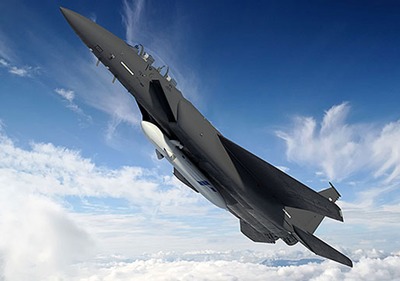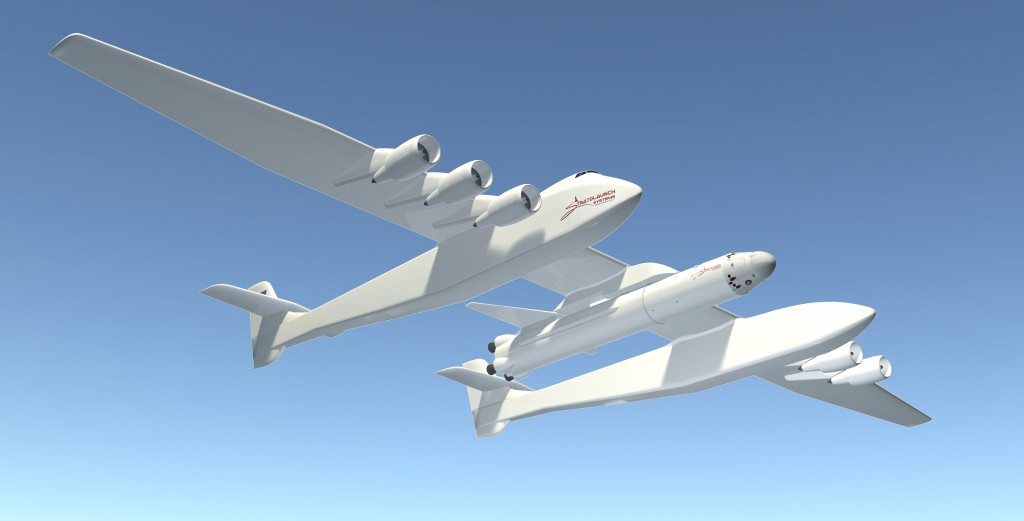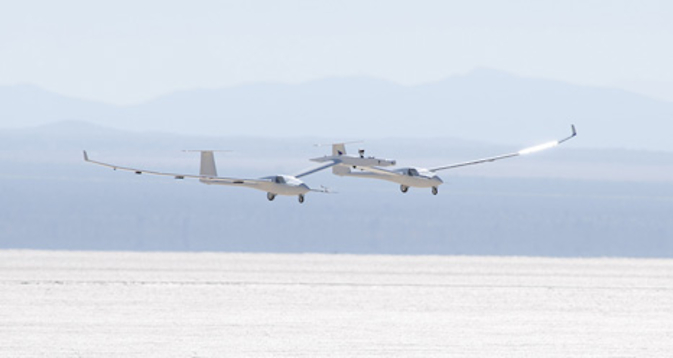November 16, 2014 – A few years ago Paul Allen, of Microsoft and X-Prize fame, proposed buying two Boeing 747s, removing an outside wing on one and an inside wing on the other and joining them together using a central spar which would be strong enough to hold a suspended chemical rocket beneath. This would replace having to launch payloads into low-Earth orbit from Earth’s surface.
Since Allen first proposed this scheme it has evolved to become Stratolaunch Systems, a project to design an airframe on a scale much larger than the White Knight Two of Virgin Galactic. Yet to be realized, what Allen’s air launch system (seen below) could do is go well beyond the sub-orbital limits of Sir Richard Branson’s space tourism project which last month came to a halt because of a fatal accident.
Stratolaunch could put humans into low-Earth orbit at high frequency and low cost when compared to ground-based rockets. Current designs will be capable of low-Earth delivery of payloads up to 6,800 kilograms (approximately 15,000 pounds), and smaller satellites to geostationary orbits. First flight tests of the airframe and rocket launch system are planned for 2016.
Air launching of payloads is not a new idea. NASA and the American military have toyed with this idea in the past. Experimental launches from commercial and military aircraft go back to the 1990s. NASA has even proposed the use of high altitude gliders to serve as platforms for air launches.
The latest NASA creation is the Towed Glider Air-Launch System (TGALS). Like White Knight Two and the Stratolaunch concept, TGALS uses a twin-fuselage joined by a central spar. Towed behind an airplane the glider reaches altitudes of 12,200 meters (40,000 feet). The glider, with a rocket attached is then released to serve as the launch platform.
On October 21 of this year NASA successfully tested a 1/3 scale prototype of the glider (8.2-meter, 27-foot wing span and seen in the picture above) with no rocket payload aboard. The pilot on board reported that the glider flew flawlessly.
Built largely from commercial off-the-shelf materials (actually two gliders joined together by a central span) TGALS will eventually be tested carrying a full payload. A test launch is anticipated as early as 2015. Of course there are payload limitations to using a glider to launch satellites into low-Earth orbit this way, but for smaller packages, this may be the way to get to space.
And not to be outdone, Boeing, under contract with U.S. Defense Advanced Research Projects Agency (DARPA) is developing the Airborne Launch Assist Space Access (ALASA) program, an air launch system that can place a 45 kilogram (100 pound) micro-satellite into orbit for less than $1 million per mission. ALASA is designed to attach to the fuselage of an F-15E jet. Like NASA’s TGALS and Allen’s Stratoguard, ALASA would be released at 12,200 meters (40,000 feet) before firing its multi-stage launcher.
Meanwhile Paul Allen’s Stratoguard has joined forces with Orbital Sciences in the past month in the hope to realize his dream. Orbital has more previous experience with airborne space launch systems than any other company. Through its Pegasus, program it has flown 42 missions over the last 24 years using a commercial jetliner as a launch platform.
But Orbital is still dealing with the recent fallout from the launchpad explosion of its Antares rocket with Cygnus supply module aboard for the International Space Station. So I would guess Stratoguard may be shunted to the side for the moment.



















Regardless of the heroic ingenuity of various schemes to reduce the cost per pound to orbit, a couple of quite inflexible “laws” dominate and constrain the possibilities.
First law: Due to the conservation of energy principle, any massive object in orbit has a minimal potential energy component (the energy required to lift it 100+ miles above the surface) and a minimal tangential orbital speed component, (the energy required to accelerate the orbiting body to 17,500 mph relative to the earth’s surface below it). Since none of the atmospheric-lift boost schemes impart any significant fraction of the minimal tangential orbital speed component, in principle, the only possible contribution they can make to total orbital energy is to lift the payload straight up the first 8-miles of the required 100-miles to orbit. In contrast to the atmospheric lift schemes, the Space Shuttle reusable solid rocket boosters provided 70%-80% of the total thrust for the first 28-miles of altitude. That is to say the Space Shuttle solid rocket boosters lifted the payload 20-miles higher than any atmospheric lift system ever could. More importantly they imparted a significant vertical velocity component of 3,000 mph.
Second “law”: The maximum practical specific impulse that a heat reaction and expulsion of chemical propellants can produce is about 500 seconds of one pound of thrust per pound of propellant expelled. That is to say if your chemical rocket has a specific impulse of 500 sec, it can produce 500 pounds of thrust for one second, during which time it will expel one pound of propellant. If you need one million pounds of thrust, you must burn and expel 2,000 pounds of LH2/Lox propellant per second. That’s as good as it will ever get with chemical rockets. No innovation can ever raise the maximum possible chemical rocket specific impulse above 500 sec.
How do these two laws bear on the practical prospects of aerodynamic lift boost of orbital payload to 8-miles with no significant vertical or tangential velocity? It seems pretty obvious the heroic airplane booster is a feeble analogy to the Shuttle solid rocket boosters. So why the interest in the heroic 8-mile-boost airplane? Does it have advantages over reusable solid propellant rockets? It eliminates the requirement for recovery and refurbishing of the spent solid propellant rockets. It allows rapid turn-around launch operations anywhere the runways are adequate. It eliminates the rocket thrust requirements for powering the first 8-miles of ascent. The first rocket stage doesn’t have to be structurally strong enough to take the shock and vibration of solid propellant boosters. Given a couple of missions per week, the cost of the first 8-miles would likely be cheaper than any vertical launch system. However most space missions would likely be intended to reach 100+ miles, and the total mission costs would likely be higher.
But there are also serious negatives. Solid propellant rockets do not have enough specific impulse to put 5,000+ pound payloads into orbit. Liquid propellants are needed for that. The concept of a large liquid propellant rocket that is fueled on its side and has high enough specific impulse to put a payload into orbit from an initial altitude of only 8-miles seems highly problematic. So it seems the concept is limited to only solid propellants (max specific impulse of ~ 250 sec) and light payloads. My guess is air-breathing booster planes will cost more to orbit tons than vertical surface launched SpaceX liquid fuel rockets. I don’t see any concept on the near horizon that will be any cheaper than Atlas Centaur or Titan III Centaur.
This is another enterprise that should await the arrival of smart robots, who will tirelessly work smart for peanuts. The present huge costs of putting big payloads into orbit relate directly to the huge number of skilled man-hours required. The only technical innovation that could change that much is smart robots.
NASA’s concept of the several Ares versions seems technically the smartest thing to boost heavy payloads to orbit I’ve seen. The highly reliable 250 sec specific impulse solid boosters are cheap and refurbishable and the 450 sec SI J-2X LOX/LH2 propellant rocket engine shares high reliability records with the Rl-10. Let the smart robots build and operate that system 20-years hence and costs might fall into the $100 pound to orbit range.
The highest priority for launch cost reduction is making as much of the booster system reusable as possible. This is what SpaceX is trying to do with no wings. There are viable ways to do the same thing with air launch (with wings). The crucial issue is how fast the upper stage with payload is moving when it is released. The shuttle SRB’s released the upper stage at over Mach 6 or 3000 mph. Most of the air launch systems would release the upper stage at about 300 mph. Since it takes about 5.6 miles per second of delta-V to reach orbital velocity at about 5 mps, the air launch imparts only a tiny portion of the horizontal orbital velocity, and a significant portion of the gravity and air drag delta-V requirement, which is about 0.6 mps.
If a winged air-breathing vehicle could be designed to reach the same speed as the SRB boosters, release the upper stage and then fly back and land, it would be able to launch a very substantial payload at a low cost. However, the cost of building a airliner-sized hypersonic aircraft would be substantial, and it would take years to design and build. I do hope that such a vehicle could be built. Meanwhile, the smaller military launchers which rely on jet fighters can launch significant payloads for their size, and have little development cost since the high speed launcher (the plane) already exists.
A major benefit of a system like Strato-launch is that it would remove the risk of pad accidents associated with vertical launches. The payload is large enough to launch an orbiter which can carry a small crew into orbit and back. For this reason alone, the system is worth developing.
[…] planes will cost more to orbit tons than vertical surface launched SpaceX liquid fuel rockets. [12] Stratolaunch could put humans into low-Earth orbit at high frequency and low cost when compared to […]